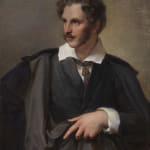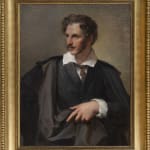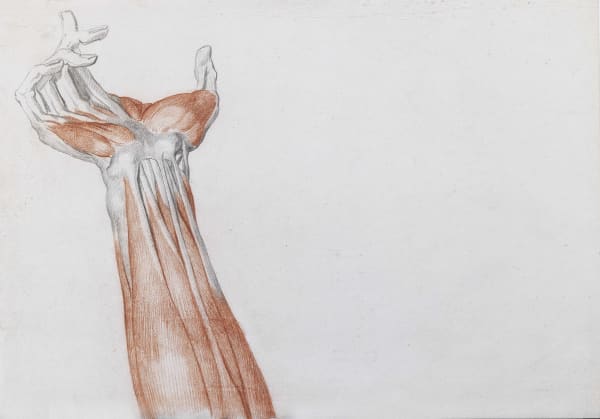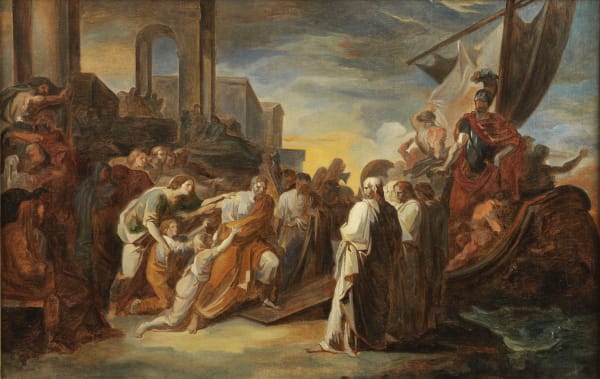


VINCENZO CAMUCCINI ROME, 1771-1844
122 x 101 x 10 cm (with the frame)
Provenance
Private collection
Exhibitions
Palazzo Vecchio, Mostra del Ritratto Italiano dalla fine del secolo XVI all’anno 1861, 1911, Florence; Palazzo delle Esposizioni, Sixteenth International Art Exhibition of the City of Venice. Exhibition of Italian Painting of the 19th Century, Rooms 7-14, 1928, Venice;
Museo Civico San Domenico, Forlì, Il Ritratto dell’Artista. Nello specchio di Narciso. Il volto, la maschera, il selfie, curated by Cristina Acidini, Fernando Mazzocca, Francesco Parisi and Paola Refice, June 2025, Forlì.

Hensel Wilhelm (1794-1861), Portrait of August Grahl, 1828
Drawing, Spreewald-Museum, Lübbenau
In our painting, the freshness of the result is accentuated by the rapid succession of confident, loose brushstrokes with which Camuccini defined Grahl’s baggy black cloak and dark jacket, against which his handsome concentrated face and hand stand out in contrast, both framed by the whiteness of the shirt. The equilibrium of this skilful and elegant balancing of black and white is sealed by the sole note of colour placed not by chance at the centre of the painting: the carelessly knotted tie. On the collar of the shirt, we can see traces of the pencil underdrawing.
It is therefore precisely the characteristics of informality and ease, both in the pose and in the workmanship, which make this painting so attractive, comparing favourably with that of Thorvaldsen, despite coming twenty years later. Both of them allow a penetrating look into the lively world of 19th-century artists in Rome, revealing that in this unofficial context Camuccini was able to give the best of himself as a portraitist.
Of this painting, shown at the exhibition of Italian portraits held in Florence in 1911, there exists a preparatory drawing in pencil, highlighted with white lead (Verdone 2005, pp. 68-69).
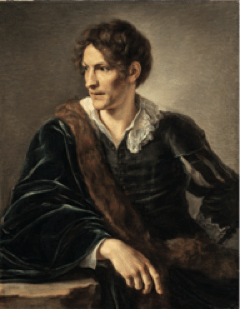
Vincenzo Camuccini, Portrait of Bertel Thorvaldsen, 1808
Oil on canvas, Private collection, Rome
-
 VINCENZO CAMUCCINIAppius Claudius. Sketch for the left-hand side of 'Death of Virginia', c. 1802
VINCENZO CAMUCCINIAppius Claudius. Sketch for the left-hand side of 'Death of Virginia', c. 1802 -
 VINCENZO CAMUCCINIForearm and hand
VINCENZO CAMUCCINIForearm and hand -
 VINCENZO CAMUCCINIDorsal region, shoulder, arm, forearm and hand
VINCENZO CAMUCCINIDorsal region, shoulder, arm, forearm and hand -
 VINCENZO CAMUCCINIThe departure of Atilius Regulus, c. 1802
VINCENZO CAMUCCINIThe departure of Atilius Regulus, c. 1802 -
 VINCENZO CAMUCCINIHoratius Cocles, 1813 - 1815
VINCENZO CAMUCCINIHoratius Cocles, 1813 - 1815 -
 Giovanni COSTANTINIThe artist in his atelier, 1891
Giovanni COSTANTINIThe artist in his atelier, 1891
Join the mailing list
Subscribe to our newsletter to receive all the news about exhibitions, fairs and new acquisitions!
